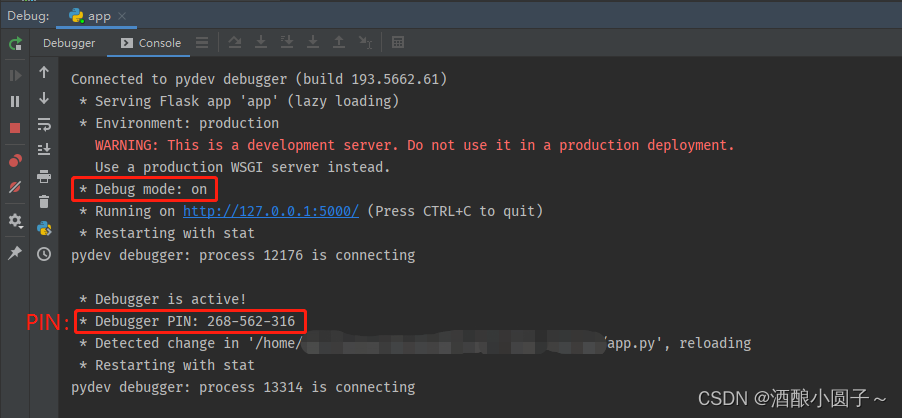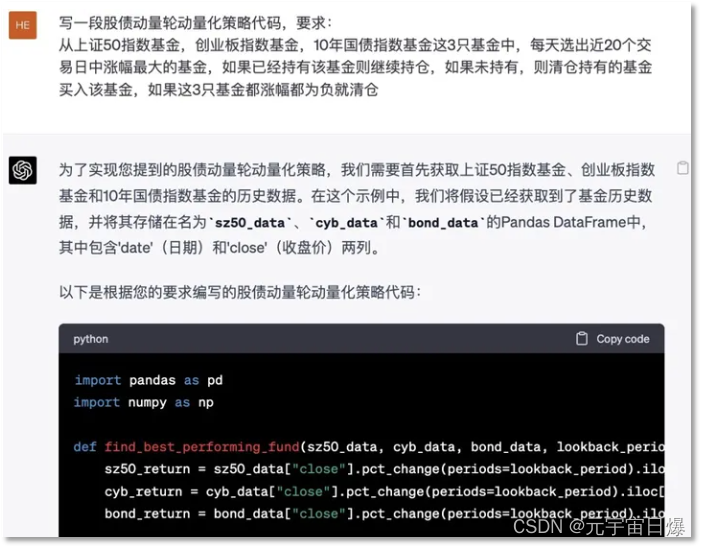爬虫学习笔记05-异步
高性能异步爬虫:在爬虫中使用异步实现高性能的数据爬取操作。
异步的意义:通过一个线程利用其IO等待时间去做一些其他事情。
异步爬虫的方式
-1.多线程,多进程(不建议):
好处:可以为相关阻塞的操作单独开启线程或者进程,阻塞操作就可以异步执行。
弊端:无法无限制的开启多线程或者多进程
-2.线程池、进程池(适当的使用):
好处:我们可以降低系统对进程或者线程创建和销毁的一个频率,从而很好的降低系统的开销。
弊端:池中线程或进程的数量是有上限的。
原则:线程池处理的是阻塞且耗时的操作。
-3.单线程+异步协程(推荐):
event_loop:事件循环,相当于一个无限循环,我们可以把一些函数注册到这个事件循环上,当满足某些条件的时候,函数就会被循环执行
coroutine:协议对象,我们可以将协程对象注册到事件循环中,它会被事件循环调用。我们可以使用async关键字来定义一个方法,这个方法在调用时不会立刻被执行,而是返回一个协程对象。
task:任务,它是对协程对象的进一步封装,包含了任务的各种状态。
future:代表将来执行或还没有执行的任务,实际上和task没有本质区别。
async:定义一个协程
await:用来挂起阻塞方法的执行。
实战代码
#需求:爬取梨视频的视频数据
import requests
from lxml import etree
import re
import os
from multiprocessing.pool import Pool
if __name__=='__main__':
url='https://www.pearvideo.com/category_5'
headers = {
'User-Agent': 'Mozilla/5.0 (Windows NT 10.0; Win64; x64) AppleWebKit/537.36 (KHTML, like Gecko) Chrome/88.0.4324.146 Safari/537.36'
}
page_text=requests.get(url=url,headers=headers).text
tree=etree.HTML(page_text)
li_list=tree.xpath('//*[@id="listvideoListUl"]/li')
urls=[] #存储所有视频的连接
for li in li_list:
detail_url='https://www.pearvideo.com/'+li.xpath('./div/a/@href')[0]
name=li.xpath('./div/a/div[2]/text()')[0]+'.mp4'
print(detail_url,name)
#对详情页的url发请求
detail_page_text=requests.get(url=detail_url,headers=headers).text
#从详情页中解析出视频的地址(url)
# ex='staUrl="(.*?)",vdoUrl'
# video_url=re.findall(ex,detail_page_text)[0] 这个方法已经不能用了
tree=etree.HTML(detail_page_text)
video_url=tree.xpath('//*[@id="JprismPlayer"]')
print(video_url,'视频地址')
dic={
'name':name,
'url':video_url,
}
urls.append(dic)
def get_video_data(dic):
url=dic['url']
print(dic['name'],'正在下载......')
data=requests.get(url=url,headers=headers).content
#持久化存储操作
with open(dic['name'],'wb') as fp:
fp.write(data)
print(dic['name'],'下载成功')
#使用线程池对视频数据进行请求(较为耗时的阻塞操作)
pool = Pool(2)
#pool.map(get_video_data,urls)
pool.close()
pool.join()
协程介绍
import asyncio
async def request(url):
print('正在请求的url是',url)
print('请求成功',url)
return url
#async修饰的函数,调用之后返回的是一个协程对象
c=request('www..baidu.com')
#创建一个事件循环对象
#loop=asyncio.get_event_loop()
#将协程对象注册到loop中,然后启动loop
#loop.run_until_complete(c)
#task的使用
#loop=asyncio.get_event_loop()
#基于loop创建了一个task对象
#task=loop.create_task(c)
#print(task)
#loop.run_until_complete(task)
#print(task)
#future的使用
#loop=asyncio.get_event_loop()
#task=asyncio.ensure_future()
#print(task)
#loop.run_until_complete(task)
#print(task)
def callback_func(task):
#result返回的就是任务对象中封装的协程对象对应函数的返回值
print(task.result()):
#绑定回调
loop=asyncio.get_event_loop()
task=asyncio.ensure_future()
#将回调函数绑定到任务对象中
task.add_done_callback(callback_func())
loop.run_until_complete(task)
多任务异步协程
import asyncio
import time
async def request(url):
print('正在下载',url)
#在异步协程中如果出现了同步模块相关的代码,那么就无法实现异步
await asyncio.sleep(2)
print('下载完毕',url)
start=time.time()
urls=[
'www.baidu.com',
'www.sogou.com',
'www.goubanjia.com'
]
#任务列表:存放多个任务对象
tasks=[]
for url in urls:
c=request(url)
task=asyncio.ensure_future(c)
tasks.append(task)
loop=asyncio.get_event_loop()
#需要将任务列表封装到wait中
loop.run_until_complete(asyncio.wait(tasks))
print(time.time()-start)
Aiohttp简单应用
import requests
import asyncio
import time
start=time.time()
urls=[
'http://127.0.0.1:5000/bobo',
'http://127.0.0.1:5000/jay',
'http://127.0.0.1:5000/rwl'
]
async def get_page(url):
print('正在下载',url)
#requests.get是基于同步的,必须使用基于异步的网络请求模块进行指定url的请求发送
#aiohttp:基于异步网络请求的模块
response=requests.get(url=url)
print('下载完毕:',response.text)
tasks=[]
for url in urls:
c=get_page(url)
tasks=asyncio.ensure_future(c)
tasks.append(task)
loop=asyncio.get_event_loop()
loop.run_until_complete(asyncio.wait(tasks))
emd=time.time()
print('总耗时',end-start)
Aiohttp实现多任务异步协程
环境安装:pip install aiohttp
使用该模块中的ClientSession
import requests
import asyncio
import time
import aiohttp
start=time.time()
urls=[
'http://127.0.0.1:5000/bobo',
'http://127.0.0.1:5000/jay',
'http://127.0.0.1:5000/rwl'
]
async def get_page(url):
async with aiohttp.ClientSession() as session:
#get()、post():
#headers,params/data,proxy='http://ip:port'
async with await session.get(url) as response:
#text()返回字符串形式的响应数据
#read()返回的是二进制形式的响应数据
#json()返回的就是json对象
#注意:获取响应数据操作之前一定要使用await进行手动挂起
page_text=response.text()
print(page_text)
tasks=[]
for url in urls:
c=get_page(url)
task=asyncio.ensure_future(c)
tasks.append(task)
loop=asyncio.get_event_loop()
loop.run_until_complete(asyncio.wait(tasks))
emd=time.time()
print('总耗时',end-start)
事件循环
理解成为一个死循环,去检测并执行某些代码
伪代码
任务列表=[任务1,任务2,任务3,……]
while True:
可执行的任务列表,已完成的任务列表=去任务列表中检查所有的任务,将‘可执行’和‘已完成’的任务返回
for 就绪任务 in 可执行的任务列表:
执行已就绪的任务
for 已完成的任务 in 已完成的任务列表:
在任务列表中移除 已完成的任务
如果 任务列表 中的任务都已完成,则终止循环
快速上手
协程函数,定义函数时 async def 函数名
协程对象,执行 协程函数()得到的协程对象
async def func():
pass
result=func()
注意:执行协程函数创建协程对象,函数内部代码不会执行。
如果想要运行协程函数内部代码,必须要将协程对象交给事件循环处理
import asyncio
async def func():
print("这是一个协程函数")
result=func()
#去生成或获取一个事件循环
#loop = asyncio.get_event_loop()
#将任务放到任务列表
#loop.run_until_complete(任务)
asyncio.run(result)#py3.7之后的更简便写法
await
await+可等待的对象(协程对象/Feture/Task对象->IO等待)
示例1:
import asyncio
async def func():
print("来玩啊")
response=await asyncio.sleep(2)
print("结束",response)
asyncio.run(func())
示例2:
import asyncio
async def others():
print("start")
await asyncio.sleep(2)
print('end')
return '返回值'
async def func():
print("执行协程函数内部代码")
#遇到IO操作挂起当前协程(任务),等IO操作完成之后再继续往下执行。
# 当前协程被挂起时,事件循环可以去执行其他协程(任务)
response=await others() #协程对象
print("IO请求结束,结果为:",response)
asyncio.run(func())
示例3:
import asyncio
async def others():
print("start")
await asyncio.sleep(2)
print('end')
return '返回值'
async def func():
print("执行协程函数内部代码")
#遇到IO操作挂起当前协程(任务),等IO操作完成之后再继续往下执行。
# 当前协程被挂起时,事件循环可以去执行其他协程(任务)
response1=await others() #协程对象
print("IO请求结束,结果为:",response1)
response2=await others() #协程对象
print("IO请求结束,结果为:",response2)
asyncio.run(func())
await就是等待对应的值得到结果只会再继续往下走。
Task对象
在事件循环中添加多个任务的。
Tasks用于并发调度协程,通过asyncio.create_task(协程对象)的方式创建Task对象,这样可以让协程加入事件循环中等待被调度执行。除了使用asyncio.create_task()函数以外,还可以用低层次的loop.create_task()或ensure_future()函数。不建议手动实例化Task对象。
注意:asyncio.create_task()函数在Python3.7中被加入。在Python3.7之前,可以改用低层次的asyncio.ensure_future()函数。
示例1(不太常用):
import asyncio
async def func(a):
print(a)
await asyncio.sleep(2)
print(a)
return '返回值'
async def main():
print("main开始")
#创建Task对象,将当前执行func函数任务添加到事件循环
task1=asyncio.create_task(func(1))
task2=asyncio.create_task(func(2))
print('main结束')
#当执行某协程遇到IO操作时,会自动化切换执行其他任务。
#此处的await是等待相对应的协程全部执行完毕并获取结果。
ret1=await task1
ret2=await task2
print(ret1,ret2)
asyncio.run(main())
示例2(常用):
import asyncio
async def func(a):
print(a)
await asyncio.sleep(2)
print(a)
return '返回值'
async def main():
print("main开始")
#创建Task对象,将当前执行func函数任务添加到事件循环
#当执行某协程遇到IO操作时,会自动化切换执行其他任务。
#此处的await是等待相对应的协程全部执行完毕并获取结果。
task_list=[
asyncio.create_task(func(1),name='n1'),
asyncio.create_task(func(2),name='n2')
]
print('main结束')
done,pending=await asyncio.wait(task_list,timeout=1) #done为任务返回值的集合,pending为等待时间
print(done,pending)
asyncio.run(main())
示例3:
import asyncio
async def func(a):
print(a)
await asyncio.sleep(2)
print(a)
return '返回值'
task_list=[
func(1),
func(2)
]
done,pending=asyncio.run(asyncio.wait(task_list)) #done为任务返回值的集合,pending为等待时间
print(done,pending)
asyncio.Future对象
Task继承Future,Task对象内部await结果的处理是基于Future对象来的。
示例1:
import asyncio
async def main():
#获取当前事件循环
loop=asyncio.get_running_loop()
#创建一个任务(Future对象),这个任务什么都不干
fut=loop.create_future()
#等待任务的最终结果,没有结果则会一直等下去
await fut
asyncio.run(main())
示例2:
import asyncio
async def set_after(fut):
await asyncio.sleep(2)
fut.set_result("666")
async def main():
#获取当前事件循环
loop=asyncio.get_running_loop()
#创建一个任务(Future对象),这个任务什么都不干
fut=loop.create_future()
#创建一个任务(Task对象),绑定了set_after函数,函数内部在2s之后,会给fut赋值
#即手动设置future任务的最终结果,那么fut就可以结束了。
await loop.create_task(set_after(fut))
#等待Future对象获取 最终结果,否则一直等下去
data=await fut
print(data)
asyncio.run(main())
concurrent.futures.Future对象
使用线程池、进程池实现异步操作时用到的对象
import time
from concurrent.futures import Future
from concurrent.futures.thread import ThreadPoolExecutor
from concurrent.futures.process import ProcessPoolExecutor
def func(value):
time.sleep(1)
print(value)
#创建线程池
pool=ThreadPoolExecutor(max_workers=5)
#创建进程池
#pool=ProcessPoolExecutor(max_workers=5)
for i in range(10):
fut=pool.submit(func,1)
print(fut)
以后写代码可能会存在交叉使用。例如:crm项目80%都是基于协程异步编程+MySQL(不支持)【线程、进程做异步编程】
import time
import asyncio
import concurrent.futures
def func1():
#某个耗时操作
time.sleep(2)
return "SB"
async def main():
loop=asyncio.get_running_loop()
#1.Run in the default loop's executor(默认ThreadPoolExecutor)
#第一步:内部会先调用ThreadPoolExecutor的sumbit方法去线程池中申请一个线程去执行
#fun1函数,并返回一个concurrent.futures.Future对象
#第二步:调用asyncio.wrap_future将concurrent.futures.Future对象包装成asyncio.Future对象
#因为concurrent.futures.Future对象不支持await语法,所以需要包装为asyncio.Future对象,才能使用
fut=loop.run_in_executor(None,func1)
result=await fut
print('default thread pool',result)
#2.Run in a custom thread pool:
with concurrent.futures.ThreadPoolExecutor() as pool:
result=await loop.run_in_executor(pool,func1)
print('custom thread pool',result)
#Run in a custom Process pool:
with concurrent.futures.ProcessPoolExecutor() as pool:
result=await loop.run_in_executor(pool,func1)
print('custom process pool',result)
asyncio.run(main())
asyncio+不支持异步的模块
import asyncio
import requests
async def download_image(url):
#发送网络请求,下载图片(遇到网络下载图片的IO请求,自动化切换到其他任务)
print("开始下载:",url)
loop=asyncio.get_event_loop()
#requests模块默认不支持异步操作,所以就使用线程池来配合实现了。
future=loop.run_in_executor(None,requests.get,url)
response=await future
print('下载完成')
#图片保存到本地文件
file_name=url.rsplit('_')[-1]
with open(file_name,mode='wb') as file_object:
file_object.write(response.content)
if __name__=='__main__':
url_list=[
'https://www.baidu.com/img/dong_8f1d47bcb77d74a1e029d8cbb3b33854.gif',
]
tasks=[download_image(url) for url in url_list]
loop=asyncio.get_event_loop()
loop.run_until_complete(asyncio.wait(tasks))
异步迭代器
什么是异步迭代器?
实现了__aiter__()和__anext__()方法的对象。__anext__()必须返回一个awaitable对象。async for会处理异步迭代器的__anext__()方法所返回的可等待对象,直到其引发StopAsyncIteration异常。由PEP492引入。
什么是异步可迭代对象?
可在async for语句中被使用的对象。必须通过它的__aiter__()方法返回一个asynchronous iterator。由PEP492引入。
import asyncio
class Reader(object):
#自定义异步迭代器
def __init__(self):
self.count=0
async def readline(self):
#await asyncio.sleep(1)
self.count+=1
if self.count==100:
return None
return self.count
def __aiter__(self):
return self
async def __anext__(self):
val=await self.readline()
if val==None:
raise StopAsyncIteration
return val
async def func():
obj=Reader()
async for item in obj:
print(item)
asyncio.run(func())
异步上下文管理器
此种对象通过定义__aenter__()和__aexit__()方法来对async_with语句中的环境进行控制。由PEP 492引入
import asyncio
class AsyncContextManager:
def __init__(self):
self.conn = 1
async def do_something(self):
#异步操作数据库
return 666
async def __aenter__(self):
#异步链接数据库
self.conn=await asyncio.sleep(1)
return self
async def __aexit__(self,exc_type,exc,tb):
#异步关闭数据库链接
await asyncio.sleep(1)
#obj=AsyncContextManager()
async def func():
async with AsyncContextManager() as f:
result=await f.do_something()
print(result)
asyncio.run(func())
uvloop
是asyncio的事件循环的替代方案。事件循环的效率>默认asyncio的事件循环。
pip3 install uvloop
import asyncio
import uvloop
asyncio.set_event_loop_policy(uvloop.EventLoopPolicy())
#编写asyncio的代码,与之前写的代码一致。
#内部的事件循环自动化会变为uvloop
asyncio.run(...)
注意:一个asgi->uvicorn内部使用的就是uvloop
异步redis
在使用python代码操作redis时,链接/操作/断开都是网络IO。
pip3 install aioredis
示例1:
import asyncio
import aioredis
async def execute(address,password):
print("开始执行",address)
#网络IO操作:创建redis连接
redis=await aioredis.create_redis(address,password=password)
#网络IO操作:在redis中设置哈希值car,内部再设三个键值对
await redis.hmset_dict('car',key1=1,key2=2,key3=3)
#网络IO操作:去redis中获取值
result=await redis.hgetall('car',encoding='utf-8')
print(result)
redis.close()
#网络IO操作:关闭redis连接
await redis.wait_closed()
print("结果",address)
asyncio.run(execute('redis://169.254.162.83',''))
示例2:
import asyncio
import aioredis
async def execute(address,password):
print("开始执行",address)
#网络IO操作:创建redis连接
redis=await aioredis.create_redis(address,password=password)
#网络IO操作:在redis中设置哈希值car,内部再设三个键值对
await redis.hmset_dict('car',key1=1,key2=2,key3=3)
#网络IO操作:去redis中获取值
result=await redis.hgetall('car',encoding='utf-8')
print(result)
redis.close()
#网络IO操作:关闭redis连接
await redis.wait_closed()
print("结果",address)
task_list=[
execute('redis://47.93.4.197:6379','root!2345'),
execute('redis://47.93.4.198:6379','root!2345')
]
asyncio.run(asyncio.wait(task_list))
异步MySQL
pip3 install aiomysql
示例1:
import asyncio
import aiomysql
async def execute():
#网络IO操作:连接MySQL
conn=await aiomysql.connect(host='127.0.0.1',port=3306,user='root',password='123',db='mysql',)
#网络IO操作:创建CURSOR
cur=await conn.cursor()
#网络IO操作:执行SQL
await cur.execute('SELECT Host,User From user')
#网络IO操作:获取SQL结果
result=await cur.fetchall()
print(result)
#网络IO操作:关闭链接
await cur.close()
conn.close()
asyncio.run(execute())
示例2:
import asyncio
import aiomysql
async def execute(host,password):
print("开始",host)
#网络IO操作:先去连接47.93.40.197,遇到IO则自动切换任务,去连接47.93.40.198:6379
conn=await aiomysql.connect(host=host,port=3306,user='root',password=password,db='mysql',)
#网络IO操作:遇到IO会自动切换任务
cur=await conn.cursor()
await cur.execute('SELECT Host,User From user')
result=await cur.fetchall()
print(result)
await cur.close()
conn.close()
print("结束",host)
task_list=[
execute('47.93.41.197',"root!2345"),
execute('47.93.40.197',"root!2345")
]
asyncio.run(asyncio.wait(task_list))
FastAPI框架
pip3 install fastapi
pip3 install uvicorn(asgi内部基于uvloop)
示例1:
import asyncio
import uvicorn
from fastapi import FastAPI
app=FastAPI()
@app.get("/")
def index():
"""普通操作接口"""
#某个IO操作10s
return {"message":"Hello World"}
if __name__=='__main__':
uvicorn.run("luffy:app",host="127.0.0.1",port=5000,log_level='info')
示例2:(程序名:FastAPI框架.py)
import asyncio
import uvicorn
import aioredis
from aioredis import Redis
from fastapi import FastAPI
app=FastAPI()
#创建一个redis连接池
REDIS_POOL=aioredis.ConnectionsPool('redis://47.193.14.198:6379',password='root123',minsize=1,maxsize=10)
@app.get("/")
def index():
"""普通操作接口"""
return {"message":"Hello World"}
@app.get("/red")
async def red():
'''异步操作接口'''
pinrt("请求来了")
await asyncio.sleep(3)
#连接池获取一个连接
conn=await REDIS_POOL.acquire()
redis=Redis(conn)
#设置值
await redis.hmset_dict('car',key1=1,key2=2,key3=3)
#读取值
result=await redis.hgetall('car',encoding='utf-8')
print(result)
#连接归还连接池
REDIS_POOL.release(conn)
return result
if __name__=='__main__':
uvicorn.run("FastAPI框架:app",host='127.0.0.1',port=5000,log_level="info")
异步爬虫实例
pip3 install aiohttp
import asyncio
import aiohttp
async def fetch(session,url):
print("发送请求:",url)
async with session.get(url,verify_ssl=False) as response:
text=await response.text()
print("得到结果:",url,len(text))
return text
async def main():
async with aiohttp.ClientSession() as session:
url_list=[
'https://python.org',
'https://www.baidu.com',
'https://www.pythonav.com'
]
tasks=[asyncio.create_task(fetch(session,url)) for url in url_list]
done,pending=await asyncio.wait(tasks)
if __name__=='__main__':
asyncio.run(main())





